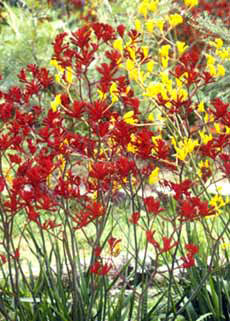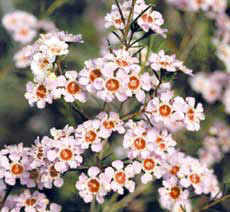
Western Australian species
The information in this document forms part of the publication Growing Australian native flowers commercially.
Some species which grow naturally in WA, and are cultivated commercially there, will also grow in NSW, for example:
- kangaroo paws
- Geraldton wax
- Dryandra.
Many more are likely to achieve this status as a result of current research by growers, breeders and propagators. One of the biggest opportunities is the use of grafting to bring difficult species into cultivation.
Anigozanthos and Macropidia species (Kangaroo paw)

Anigozanthos
Several species of kangaroo paw and numerous hybrids are grown for their striking cut flowers, with most commercial plantings based on tissue-cultured plantlets. Kangaroo paws have a relatively short production cycle, with plants flowering for the first time about 6 months after planting. Well-drained, frost-free sites are needed. These are a major export crop for NSW growers.
Australian breeders have produced a large number of varieties with attractive flower colours and forms as well as disease resistance, as have Israeli breeders.
Successful marketing requires a good understanding of crop scheduling and selection of varieties to suit a particular market, especially as kangaroo paws are being grown on a large scale by overseas producers based in Israel, Japan, USA, and South African and South American countries.
Key references
Carson, C et al. 2000, ‘Kangaroo paw’, in Should I grow wildflowers?, Agrilink Horticulture Series QAL 0001, Queensland Department of Primary Industries, Brisbane. For more information contact Queensland Department of Primary Industries.
Stewart, A 2002, ‘Crop reinvention — kangaroo paw’, in Proceedings 6th Australian Wildflower Conference, 30 May–1 June 2002, Warwick Farm, Sydney. Copies available from NSW Department of Primary Industries.
Worrall, R & Young, K 1998, ‘Kangaroo paw’, in The New Rural Industries — A Handbook for Farmers and Investors, RIRDC, Canberra.
Chamelaucium uncinatum (Wax flower)

Chamelaucium uncinatum
Wax flower forms a large bush and there is now a wide range of colours and varieties as a result of extensive breeding and selection in Australia and overseas. It is considered suitable only for selected parts of NSW — large producers in WA and Queensland have competitive advantages in terms of flowering season and scale of operation.
Wax flower requires well-drained soils and is susceptible to root diseases.
Key references
Carson, C et al. 2000, ‘Waxflower’, in Should I grow wildflowers?, Agrilink Horticulture Series QAL 0001, Queensland Department of Primary Industries, Brisbane. For more information contact Queensland Department of Primary Industries.
Considine, JA & Growns, D 1998, ‘Geraldton wax and relatives’, in The New Rural Industries — A Handbook for Farmers and Investors, RIRDC, Canberra.
Growns, D & Parlevliet, G 2002, ‘Reinventing waxflower’, in Proceedings 6th Australian Wildflower Conference, 30 May–1 June 2002, Warwick Farm, Sydney. Copies available from NSW Department of Primary Industries.
RIRDC, Waxflowers for floriculture — collection and selection, RIRDC Publication No. 99/29.

